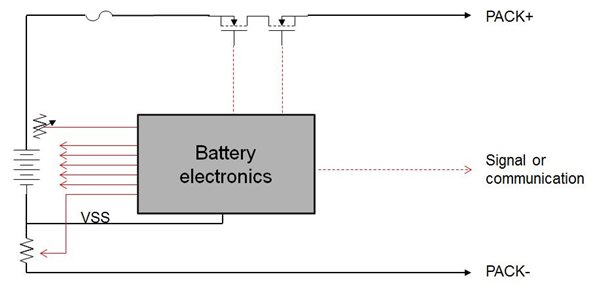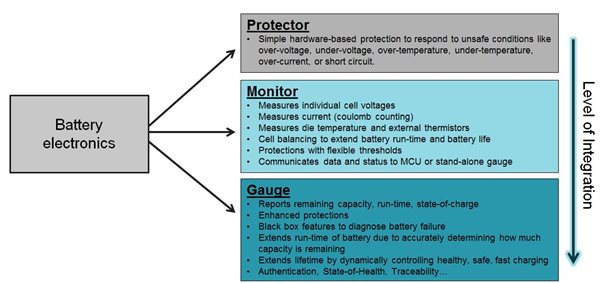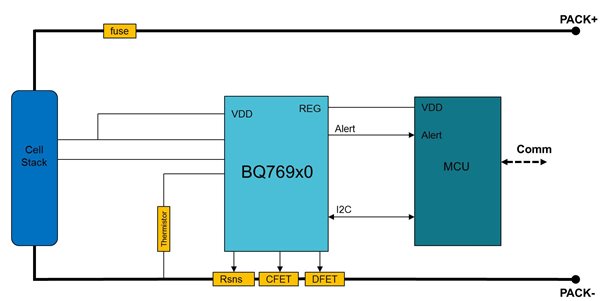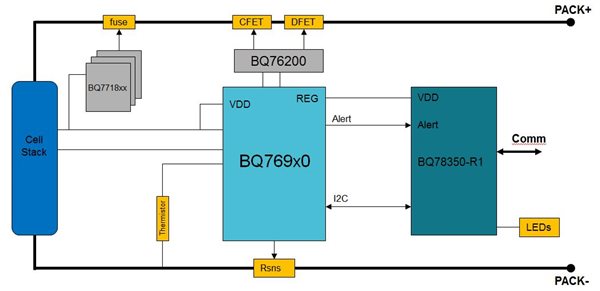SSZT466 june 2019 BQ76200 , BQ76920 , BQ76930 , BQ76940 , BQ7718 , BQ78350-R1
Lithium-ion batteries have high energy density and a long cycle life; they also lack the memory effect of other technologies. Such characteristics make them attractive for portable electronic systems. But lithium-ion batteries also need to operate within specified limits to be used safely, so batteries require electronics designed to respond or provide a signal to the system if the limits are exceeded.
Battery electronics monitor multiple conditions such as voltage, current and temperature and how they change over time. They need to sense the required combination of these parameters in order to respond, whether that’s sending a signal to the system, activating a switch to prevent charge or discharge, or opening a fuse. Figure 1 below shows an example of how the battery electronics might be configured in a typical battery pack.
 Figure 1 Battery Electronics within a
Battery Pack
Figure 1 Battery Electronics within a
Battery PackThe type of battery electronics varies depending on the type of battery pack. Simple packs may need only a simple protector, ranging from a basic overvoltage protector to a more advanced protector that responds to under-voltage, temperature faults or current faults. Protectors can also operate as a secondary device along with a monitor or battery gauge.
Many advanced battery packs used in higher-cell-count batteries require a battery monitor. A battery monitor measures individual cell voltages, battery current and temperature, and reports these values to a gauge or microcontroller. The system uses this information to adjust performance accordingly; for example, by reducing the operating current if the temperature is too high. Battery monitors may provide a cell-balancing feature to extend battery run times as well as battery lifetimes. Monitors can also include protections available in integrated circuits (ICs), but with much higher configurability.
A gauge IC integrates the features of a battery monitor with a controller to provide advanced gauging algorithms. Gauge ICs report the remaining battery capacity, run time and state of charge. Software-based algorithms can enhance protections even further. Gauges often include other useful features such as a black-box function that helps diagnose battery packs that failed in the field, lifetime data logging of minimum and maximum parameter conditions, dynamic charger control, or authentication for secure batteries.
Figure 2 below outlines some of the key feature differences between the different types of battery electronics.
 Figure 2 Feature Differences between
Protectors, Monitors and Gauges
Figure 2 Feature Differences between
Protectors, Monitors and GaugesWhat Features Are Most Critical in Choosing the Optimal Battery Electronics for Your System?
- Protectors offer the lowest complexity for simple pack designs.
- Monitors offer the highest flexibility. You can write code specific to your system needs, which is often important when those needs are unique.
- Gauge ICs offer the highest level of integration. They offer high-accuracy state-of-charge information and faster development time – since firmware is included – but might limit flexibility.
Figure 3 shows an example solution using the BQ769x0 battery monitor. The family includes devices for five- (BQ76920), 10- (BQ76930) and 15-cell (BQ76940) batteries. You can use the same controller software for any of the devices in the family, enabling flexibility for systems to go from three to 15 cells in series. The monitor continuously measures cell voltages, temperature and current through the sense resistor and reports this information to the microcontroller. It provides multiple configurable hardware protections and will open charge and discharge field-effect transistors (FETs) as needed to respond to fault conditions. The microcontroller can make decisions based on the information provided by the monitor – it can also enable/disable the FETs; control the cell-balancing feature; and even perform some basic gas gauging based on voltage, current and temperature information.
 Figure 3 Example Battery Monitor
Solution Featuring the BQ769x0 with a Microcontroller
Figure 3 Example Battery Monitor
Solution Featuring the BQ769x0 with a MicrocontrollerFigure 4 is an example of a slightly more advanced battery pack. Here, you see the same monitor family working with the BQ78350-R1 companion controller. The BQ78350-R1 comes equipped with firmware designed to work directly with the BQ7620, the BQ76930 or the BQ76940 digital monitor, helping accelerate product development. The BQ78350-R1 also performs fuel gauging and state-of-health reporting and includes many other features commonly included in TI fuel gauges, such as lifetime data logging and black-box recording.
 Figure 4 Advanced Battery Pack
Featuring the BQ769x0, BQ78350-R1 Controller with Fuel Gauge, BQ76200 High-side
FET Driver and BQ7718 Secondary Protector
Figure 4 Advanced Battery Pack
Featuring the BQ769x0, BQ78350-R1 Controller with Fuel Gauge, BQ76200 High-side
FET Driver and BQ7718 Secondary ProtectorMany systems require the redundancy of a secondary protector for overvoltage. This example features the BQ7718 stackable overvoltage protector, which can directly open a fuse if the primary protector fails.
Some systems may require the use of high-side FETs. High-side FETs enable continuous communication to the pack regardless of whether they are on or off. This means that the system can read critical pack parameters despite safety faults, and access pack conditions before allowing operations to resume. The BQ76200 high-side N-channel FET driver works well with the BQ76920, BQ76930 and BQ76940 monitors in systems needing high-side FETs.
There are many things to consider when designing systems with Lithium Ion batteries for safety and battery performance. Depending on the system needs, the appropriate protector, battery monitor or gauge can be selected.
Additional Resources
- Learn more about TI’s battery protectors, battery monitors or fuel gauges.
- Watch the training video, Battery protector, monitor, or gauge?